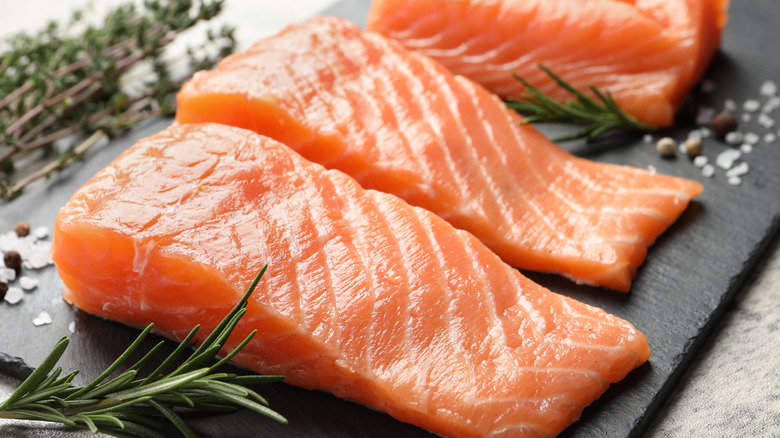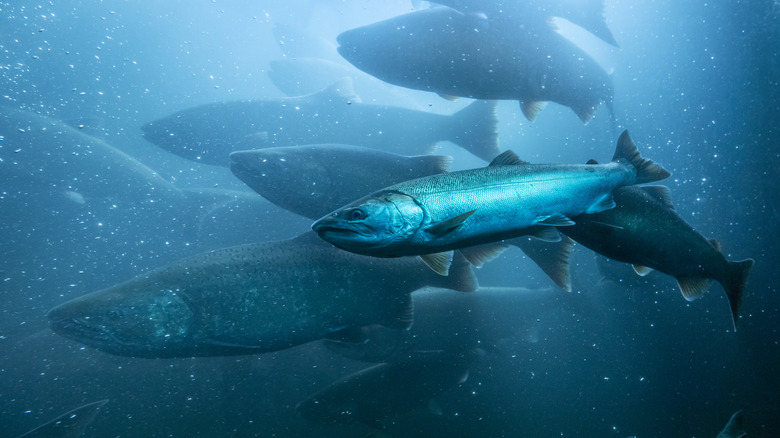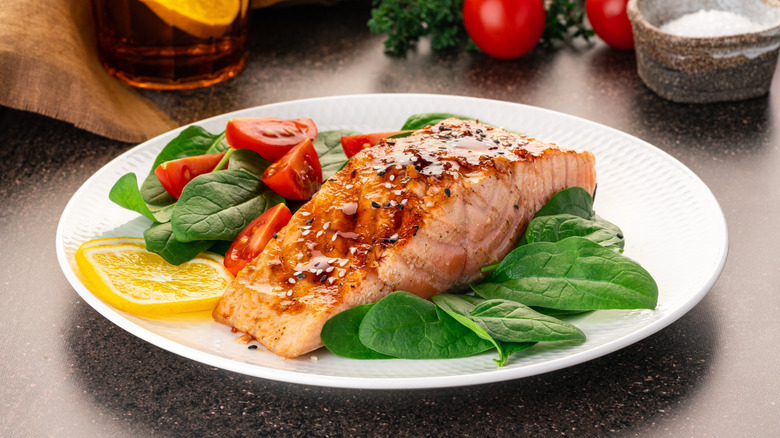How To Tell If Your Olive Garden Salmon Is Farm-Raised Or Wild-Caught
On an average year, Americans collectively eat around 420,000 metric tons of salmon in an assortment of recipes, which is a lot of fish. When it comes to restaurants, salmon is a popular seafood offering popping up on menus at establishments like Olive Garden. Is the salmon at the Italian restaurant chain farm-raised or wild-caught, and how can you tell the difference?
Farm-raised salmon gets a bit of a bad rap with concerns over its sustainability and overall nutritional value, making some consumers second guess the fish. It should be easy to tell from looking at the salmon on your plate whether it's farm-raised. Wild-caught salmon has a slightly different color than farmed-raised salmon. It's more of a reddish-orange than a pinkish-orange, as is the case of farm-raised. Farm-raised salmon is naturally white since the fish doesn't have the same diet as its wild kin, but farmers add carotenoids, which are pigment compounds, that give the fish a similar but distinctly different hue. Wild fish also tend to have stronger tails, making it more pronounced on their bodies comparatively, but this is unlikely to help you at Olive Garden since the restaurant serves salmon filets.
Taste obviously plays a crucial factor. Wild salmon have a stronger, more distinct taste that some may find fishy compared to a duller, more neutral flavor of farm-raised salmon.
Multiple factors play a role
If you're in doubt about whether your salmon at Olive Garden is farm-raised or not, the best course of action is to ask your server before ordering. They can better advise you on the origin of your fish, and then you can make a better judgment call. However, at first glance, there's arguably little guesswork on whether Olive Garden uses farm-raised or wild-caught salmon. The restaurant chain admitted it used mainly farm-raised salmon on its social media page in 2015. However, Olive Garden also sells wild-caught salmon at some of its locations — though which locations serve it are harder to figure out. Several factors go into whether a restaurant can serve wild-caught salmon, including the time of the year, as well as the supply and distribution.
Salmon is typically caught between the late spring and early fall, making the fish more abundant during this time period. If you're eating salmon in late winter, it could be because it's farm-raised. Given that wild-caught salmon is sought after, many will use it to market their dishes.
Farm-raised salmon is prevalent
It's entirely possible that you've been eating farm-raised salmon most of your life without ever realizing it. According to CBS, most of the salmon served in the United States come from fish farms. Farmed fish production has even surpassed beef production. A study by the conservation group Oceana determined that some restaurants are misrepresenting the fish they serve, marketing farm-raised salmon as wild-caught in an attempt to draw in customers. Knowing the distinct characteristics of both will help you prevent falling victim to any bait-and-switch schemes.
That being said, the salmon farming industry has made advancements in recent years to offer consumers a better product and rid itself of some of that negative reputation it has garnered. According to Healthline, the actual contaminants and pollutants in farm-raised salmon are small and unlikely to affect one's health. The industry as a whole has made improvements to limit the fish's exposure.
In an interview with CBS, Dr. Sanja Gupta said, "The farmed salmon industry has changed what they're feeding their salmon over the years and it's improved." In most cases, the salmon at Olive Garden is likely farm-raised, but now you know how to tell the difference. Farm-raised salmon may not be as premiere as wild-caught, but it isn't necessarily bad.


